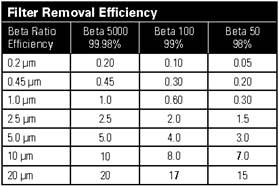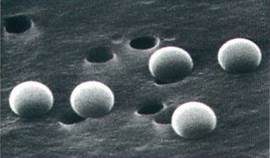Filtration Efficiency
Understanding Retention Efficiencies for Filter Cartridges
 Selecting
the proper filter cartridge retention for a given application reduces operating costs and ensures process specifications are achieved.
Filter cartridge retention is expressed in microns (μm); 1 micron =
1/1000 (0.001) millimeters.
Selecting
the proper filter cartridge retention for a given application reduces operating costs and ensures process specifications are achieved.
Filter cartridge retention is expressed in microns (μm); 1 micron =
1/1000 (0.001) millimeters.
Nominal Efficiency is a manufacturer
defined efficiency and for our nominal rated filter cartridges they are
70% efficient unless otherwise specified. Therefore, with a new
(clean) filter cartridge,
=>70% of the particles of the stated retention
will be retained by the filter cartridge. As particles become trapped
within the filter cartridge media, the open area available decreases and
thereby increases the efficiency of the filter cartridge.
As mentioned above, there is no
"universal" retention efficiency required to be referred to as "nominal"
- it is manufacturer defined, often not overtly stated; you will need
to ask if your application is one of those sensitive to the initial
retention efficiency.
Therefore it is incorrect to assume that
two different brands of "50 micron nominally rated filter cartridges"
have the same efficiency; you will need to try each to determine which
is the best value for your application. Generally speaking the
more efficient the media is, the more costly it is because the
manufacturers of the filter media can get top dollar for the more
efficient portion of the media run.
In comparison to absolute rated filter
media, nominal rated filter cartridges are relatively inexpensive and
used for non-critical applications. They are also used as
"pre-filters" to reduce the loading on the more expensive "absolute"
efficiency filter cartridges.
Absolute Efficiency is much more
intuitive and straightforward to understand. It refers to a
laboratory defined retention efficiency, often expressed with a
Beta
value or a Beta Ratio. Most of our
absolute rated filter cartridges have a Beta
Ratio Chart expressing their efficiency based upon a stated particle
size.
 Example:
our LOFPLEAT-HP 1.0 micron filter cartridges have a Beta 5000 or
99.98% retention efficiency for particles => 1.0 micron. They can
also be described as Beta 100 (99%) efficient for retention of particles
=> 0.60 microns or Beta 50 (98%) efficient for retention of particles =>
0.30 microns.
Example:
our LOFPLEAT-HP 1.0 micron filter cartridges have a Beta 5000 or
99.98% retention efficiency for particles => 1.0 micron. They can
also be described as Beta 100 (99%) efficient for retention of particles
=> 0.60 microns or Beta 50 (98%) efficient for retention of particles =>
0.30 microns.
The Beta Ratio is established via
laboratory testing and is the number of particles up-steam of the
cartridge divided by the number of particles downstream of that same
cartridge for the targeted particle size.
Therefore a Beta ratio of 5000 means that for every
particle of a given size that bypasses the filter cartridge, there were
4999 that did not. The math follows:
![]() Beta
5000 = 4999 particles retained from a total of 5000 and therefore 4999/5000 = 99.98%
efficiency.
Beta
5000 = 4999 particles retained from a total of 5000 and therefore 4999/5000 = 99.98%
efficiency.
The testing methods used to determine
efficiency can be complex and they are not to a universal standard; each
manufacturer determines how they will test their efficiencies.
The testing method used for Eaton's Beta
Ratios are based upon a "single-pass test method" using ambient water at
a flow rate of 2.5 GPM for a 10" length cartridge. The type of
particles used during testing are latex beads and special "coarse and
fine test dust" (imagine that, "test dust"!). The removal efficiencies
are determined using multiple laser particle counters which is the most
sophisticated and effective method of counting "dust" particles.

The
actual efficiency for your application will differ due to operating
conditions such as pressure fluctuations, differences in temperature and
viscosity. This is another reason why trying different filter
cartridge brands, media and designs can be beneficial to you, your
process results will not likely correlate directly to "retention sizes
or efficiencies" due to process variations anyway.
It is important not to confuse filtration
efficiency with particle retention capacity; they are unrelated.
The total volume of particles that can be retained within a cartridge
and how the rate of increase in efficiency due to reduction of the open
area available are not reflected in the Beta Ratio and testing.
Underscoring once again that the physical design of the filter cartridge
may offer capacity advantages even if the media used is the same across
multiple brands/designs.

Our
differential performance advantage compared to other brands are often
based upon the manufacturing technology and design of the filter
cartridge to provide higher volume of particle retention at relatively
low differential pressures without sacrificing retention efficiency.
The picture above illustrates a pleated design, although other advanced
features can include a fixed pore structure that prevents particle
unloading even under high differential pressures or a heavy molded
"cage" to increase the overall integrity/strength of the filter
cartridge.
Do you require nominal or absolute rated
filter cartridges?
If you have sensitive applications
requiring absolute rated media, you probably already know it and have an
application that involves the food, beverage, pharmaceutical, cosmetics
or petrochemical industries. It is important to note that the
lesser expensive nominal rated cartridges can be used to extend the life
of the much more expensive absolute rated cartridges, so the answer
might be "both"!
We can provide you with free filter
cartridges for testing and evaluation combined with free water test
analysis/report which will characterize the particle sizes and
population within a given sample that you provide. The analysis
eliminates "trial and error" for proper filter cartridge material and
design. Why not take advantage of these free services today?



